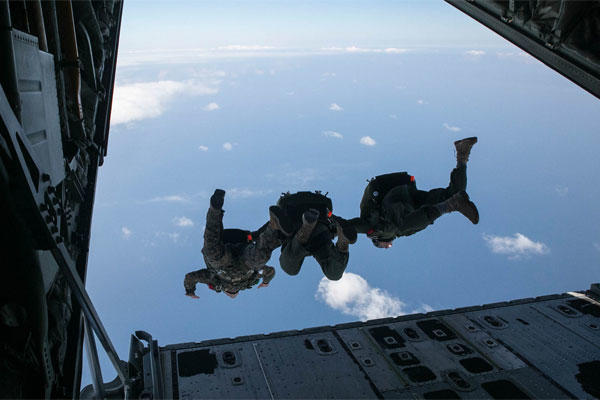IE SHIMA TRAINING FACILITY, OKINAWA, Japan -- “Five minutes!” yelled the jumpmaster as he signaled the Marines to get out of their seats. They stood up and made their way to the rear of the aircraft. They are almost at the drop zone – it’s go time.
This scene played out several times as Marines with 3rd Reconnaissance Battalion conducted parachute training Nov. 20, 2014 over Ie Shima Training Facility, off the Northwest coast of Okinawa, Japan.
As recon Marines in the Pacific area of operations, these Marines are some of the first responders to any potential crisis if called upon by the U.S. Government. With current events in the Pacific, keeping ready for missions is key.
Reconnaissance men and air delivery specialist Marines with the battalion jumped from a KC-130J Super Hercules aircraft, giving them added experience with air drop operations while also maintaining their jump proficiency.
“The main focus of this training is to keep a currency in each jumper,” said Master Sgt. Raul Argumedo, an air delivery specialist and jumpmaster with 3rd Recon Bn., 3rd Marine Division, III Marine Expeditionary Force. “Every six months they have to do at least one jump to keep up with their qualifications and stay up to speed.”
The Marines conducted two different types of jumps for the training based on their individual jump qualifications.
A majority of the Marines involved conducted low level static line jumps, where the jumper is released from the aircraft at a low altitude and their chute is pulled by the aircraft as they exit. The Marines did their static line jumps from 1,500 feet for this training.
The Marines with higher qualifications conducted freefall jumps, where the jumper exits the aircraft at high altitudes anywhere from 4,500 feet to 25,000 feet and pull their chute manually. The freefall jumps took place from 10,000 feet for this training, said Argumedo from Los Angeles, California.
Both jump methods are valuable to reconnaissance Marines, giving them a stealthy approach on the enemy during real world missions.
“Being able to jump out of a plane, whether it is static line or freefall, is just another insert capability that we have as recon Marines,” said Cpl. Gregory H. Steiner, from Buffalo, New York. “If we aren’t diving or humping it in, this is another way we can get to where we need to be to conduct our surveillance.”
Each Marine jumped twice during the training. The first jump was performed “Hollywood style,” equipped with only their parachutes. For the second jump, the Marines strapped combat packs weighing over 50 pounds.
The training was a great opportunity for the Marines, one that they don’t get as often as they would like, said Steiner.
“Being out in Okinawa we actually don’t get a lot of time to practice our jump capability,” said Steiner, a reconnaissance man with the battalion. “There are limitations with the weather and this kind of training gets cancelled a lot.”
Argumedo said the training was an important learning curve for many of the Marines. About three quarters of them were conducting their first jumps since their initial parachute training.
“The major thing the Marines got today was more experience,” said Argumedo. “Most of the guys we’ve got here today did their first jump in the fleet. As everybody knows, being in a school scenario is totally different than how things work in the fleet. I think these guys got a lot out of that.”
The Marines performed well during the training, said Cpl. Christian M. Garcia, from Phoenix, Arizona.
“I thought the training was good,” said Garcia, a reconnaissance man with the battalion. “Everyone hit the drop zone and nobody was injured which is a big thing. It’s always good to get up there and refresh yourself on this stuff. It makes you more comfortable. ”


























